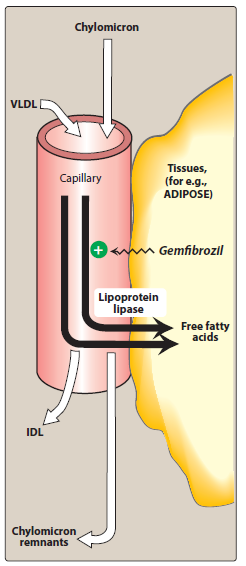
Fibric acid derivatives (Fibrates)
- Fibric Acid Derivatives are derivatives of fibric acid. They are used to lower blood triglyceride level.
- The first fibrate discovered was clofibrate in 1962. It was followed by subsequent introduction of gemfibrozil, fenofibrate, bezafibrate and ciprofibrate.
Indications of Fibric Acid Derivatives
- Fibric Acid Derivatives are used in treatment of hypertriglyceridemia.
- They are useful in treating type III hyperlipidemia in which IDL (Intermediate Density Lipoproteins) are accumulated.
- They are used for treating severe chylomicronemia syndrome. Fibrate maintenance therapy and low-fat diet in patients with chylomicronemia syndrome helps to keep triglyceride level below 1000 mg/dl and help to prevent pancreatitis.
Mechanism of action of Fibric Acid Derivatives

Figure- Mechanism of action of fibrates (Source- Lippincott’s Illustrated Reviews)
- They bind to nuclear transcription receptor, PPAR-α (Peroxisome Proliferator Activated Receptor-α) which regulate lipid metabolism. PPAR-α is expressed primarily in liver and brown adipose tissues. This binding activates PPAR-α which increase expression of lipoprotein lipase and Apo C-II. This will decrease VLDL (Very- Low Density Lipoprotein) level.
- This will also increase expression of proteins which help to transport free cholesterol out of cells and expression of major apoprotein (apo AI and apo AII) in HDL.
Effects on lipid concentration
- They lower VLDL level and increase HDL. They have little effect on LDL.
- The plasma triglyceride declines by 50% and cholesterol by 10-15%. HDL increases by 20%.
Pharmacokinetics
- They are completely absorbed after oral administration. Their absorption is enhanced when taken with meal.
- They are highly protein bound (around 90%). They are distributed widely. Peak plasma concentration is achieved within 1-4 hours. They are metabolized by hepatic cytochrome P450 (CYP) 3A4. They are excreted via kidneys.
- Fenofibrate is a prodrug which is converted to active moiety; Feno fibric acid.
Adverse effects
- Gastrointestinal disturbance is most common adverse effect. These effect decreases as therapy progresses. They can produce allergic reaction, nausea and diarrhea. Long term therapy may cause gallstone formation.
- Myositis (inflammation of voluntary muscle), muscle weakness or tenderness can occur.
Drug Interactions
- Chances of myopathy and rhabdomyolysis are there when used in combination with other statins. Hence, dose of statin should be reduced when used in combination. Gemfibrozil and statins when used together, it inhibits hepatic uptake of statins and compete for glucoronosyl transferase that metabolize most statins. This may cause increase in plasma concentration of both drugs. Patients taking this combination should be monitored for creatinine kinase value at regular interval.
- They potentiate action of oral anticoagulants by displacing them from their binding sites. Hence, prothrombin time should be monitored when used in combination. Dose of oral anticoagulants should be reduced.
Contraindications
- They are contraindicated in patients with renal or hepatic dysfunction or with preexisting gallbladder issues.
- They should be avoided in alcoholics with hypertriglyceridemia who are predisposed to myositis.
References
- Miller DB, Spence JD. Clinical Pharmacokinetics of Fibric Acid Derivatives (Fibrates). Clinical Pharmacokinetics. 19998; 34: 155–162.
- Pharmacology and Pharmacotherapeutics. 24th edition.
- Goodman and Gillman Manual of Pharmacology and Therapeutics.
- Lippincott Illustrated Reviews Pharmacology, 6th edition.